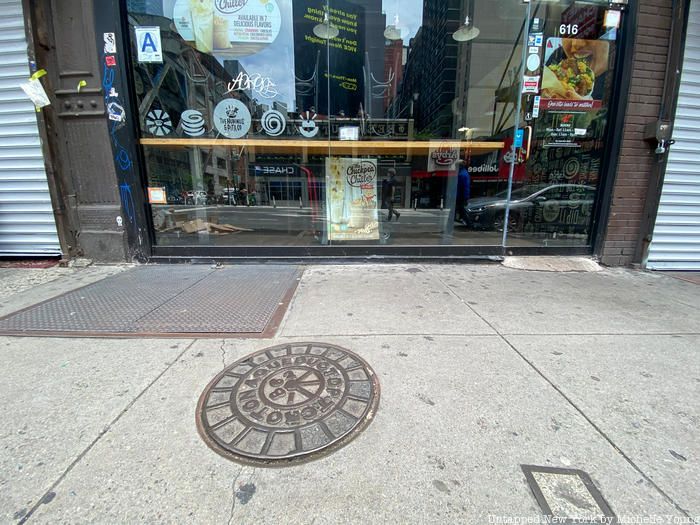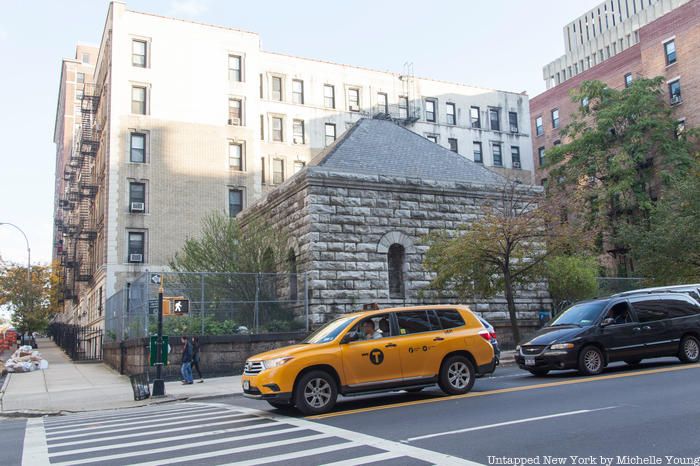Last Chance to Catch NYC's Holiday Notalgia Train
We met the voices of the NYC subway on our nostalgia ride this weekend!


Tracking manhole covers is definitely one of the nerdiest of the urban nerd activities out there. I would know, having written a treatise in graduate school just on the manholes of Westminster Abbey (there are more than fifty in there, including four by my favorite company Thomas Crapper & Co.!). My team here at Untapped New York has been tracking the manholes in New York City too of course, but with constant roadwork, some of the oldest keep disappearing.
For years, a Croton Aqueduct manhole cover on Jersey Street next to the Puck Building on Soho was often cited as the oldest, or one of the oldest manholes in New York City. Roadwork in 2017 wiped away its existence and the letters “CROTON AQUEDUCT D.P.T. 1866” had long been weathered down by the 150 years of traffic over it. The quest then remained to find the next manhole that could be crowned the oldest.
Turns out, another Croton Aqueduct manhole cover — even older than the Jersey Street one — had been here all along. Dating to 1862, as evidenced by the cast-iron numbers, this manhole is even better preserved because it sits on a sidewalk and not in the road. It is located in a far less charming location — across from the Port Authority Bus Terminal on 40th Street and 8th Avenue in front of The Hummus & Pita Co., a chain restaurant.

Another Croton Aqueduct manhole cover, dating to 1866 in East Harlem, is also well-preserved because it is situated inside Thomas Jefferson Park on the walkway off 112th Street and 1st Avenue. These manholes were part of the old Croton Aqueduct system, a 32-mile gateway that provided clean water from Westchester to New York City. The advent of the Croton Aqueduct was a boon for public health, offering clean water for the masses and reducing the proliferation of epidemics like cholera. Within Manhattan, the aqueduct system ran down Amsterdam Avenue, through Central Park and down Fifth Avenue to where Bryant Park is now, where a reservoir collected the water.

The old Croton Aqueduct system was also one of the reasons for the consolidation of New York City, forming the five boroughs. Brooklyn, for example, was struggling with its own water system built in the 1850s at the Ridgewood Reservoir, as water closer to the city became more polluted. Water was even being tapped from Long Island aquifers but silt and salt water intrusion in Long Island water created difficulties for the reservoir system. Suffolk County also, unsurprisingly, banned Brooklyn from taking any of its water. It became clear that the Croton Aqueduct system, which moved water by gravity would be more cost effective and provide better quality water.

Remnant of the original reservoir at 42nd Street inside the New York Public Library
You can still see numerous remnants of the old Croton Aqueduct system all over New York City, including remnants of the original reservoir that are located inside the New York Public Library main branch, gatehouses, and of course, the manholes. It is important to note that only some of the manholes that read Croton Aqueduct are located along the line of the original aqueduct, since the water was distributed throughout the city.

Croton Aqueduct gatehouse on Amsterdam avenue at 119th Street
The years on the manholes do carry some importance. As Susan Johnson, curator of the 2017 exhibition To Quench the Thirst of New Yorkers at The Museum of the City of New York, tells Allison Meier in Hyperallergic, “The Croton Aqueduct Department was formed in 1849 by New York State. It oversaw maintenance and improvements to the Croton Aqueduct and its structures, the pipes that brought water from the reservoirs for public use, and the construction and maintenance of sewers. In 1866 — the year marked on the manhole cover — the department spent $934.81 on new iron manholes and stone covers for sewer basins.”
Several of the remaining Croton Aqueduct manholes have been from 1866 — the Jefferson Park one, the former Jersey Street one, and one that can be found in Central Park near 85th Street and Central Park West. The very detailed website Beyond Central Park notes that the Central Park manhole (and a nearby one with the year 1867) are along the route of the old Croton Aqueduct, where the original masonry conduit was replaced with underground pipes between 1866 and 1867.
Along the Amsterdam Avenue stretch of the Croton Aqueduct path, you will also find additional manholes which read D.P.W. Sewer and the year. The below is located at 122nd Street and Amsterdam Avenue, dates to 1874:

Across from the Museum of the City of New York at Fifth Avenue and 105th Street is an ornamented Victorian-style Croton Aqueduct manhole. Based on our research, we believe it is probably from the “new” Croton Aqueduct system, the upgrade that happened in 1890.

Worthy of mention also in this article is the existence of coal holes, where you may find dates even prior to the 1862 Croton Aqueduct manhole. Like in London, the original street covers were for coal — and were often originally rectangular in shape. New York City still has many covers that lead to former coal chutes, like the one below in a hexagonal shape. This particular one, found in Brooklyn Heights, is a patented “illuminated cover” invented by J.B. Cornell, an ironworks company founded by brothers on Centre Street, and dated 1856. Jeremy Lechtzin, who founded the website 80s.nyc tells us that dates on coal covers show the patent date and not the installation date, which may have occurred decades later.

The patent document describes glass panes placed between melted brimstone. John B. Cornell writes that the design will be kept clean from the “friction of passing feet,” and that a light rain shower would remove “any considerable quantity of dirt” from the glass panes. For this and various reasons, Cornell believed “in point of illuminating power, and safety against the entrance of moisture, I believe that my improved illuminating cover for openings in pavements &c. has no equal.”
UPDATE: This manhole cover has since been removed by the NYC Department of Environmental Protection for safekeeping and is now in the DEP Archives! See an equally old manhole in Central Park and one even older!
For more manhole fun, check out 10 unique and artistic manhole covers in NYC.
Subscribe to our newsletter